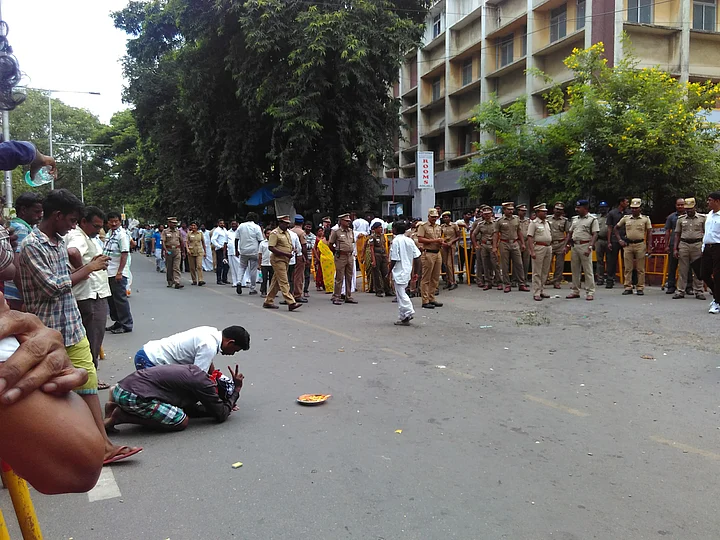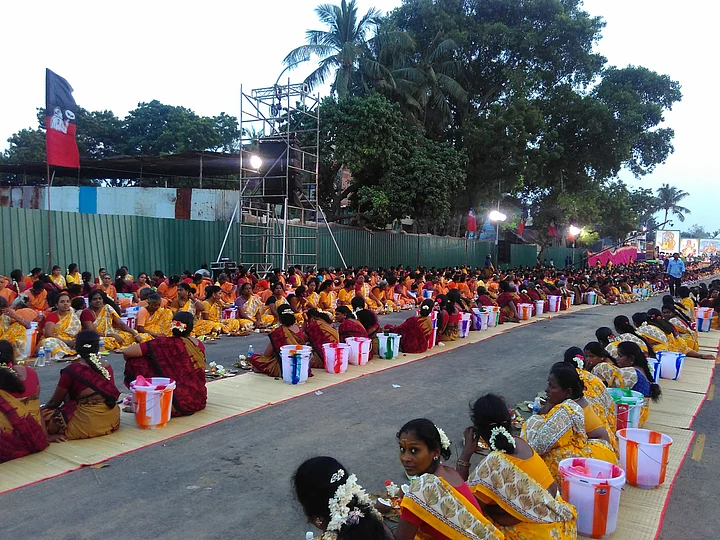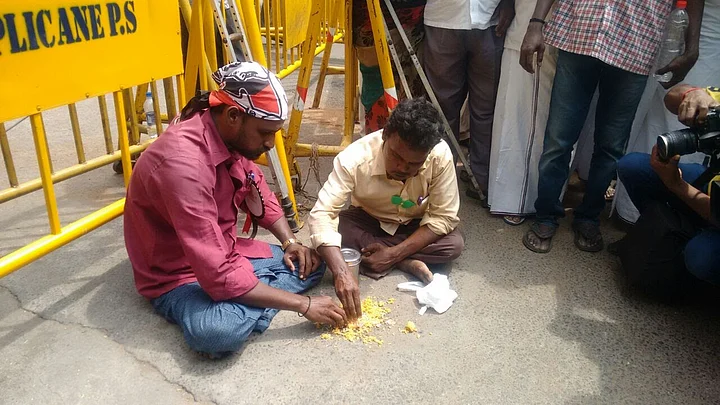(The article was originally published on 5 December 2018. It has been reposted from The Quint’s archives to mark J Jayalalithaa’s birth anniversary.)
Since the day J Jayalalithaa was admitted in Apollo Hospital in Chennai, I found myself a new hangout spot. On a yellow barricade on the right side of the gate where a crooked slab would be balancing a horde of microphones.
Everyday, my head office would come up with interesting story angles to work on. Do a walkthrough in the hospital right outside the leader’s chamber, they would suggest. Perhaps a beautifully written story on how she interacts with nurses and ward boys? Or a quick conversation with her consulting doctors, if not the chief doctor.
I would feel frustrated. When the likes of Venkaiah Naidu, Vidyasagar Rao and Rahul Gandhi couldn’t get an entry pass into even the corridor where her room was, what was a journalist with a bulky camera and a microphone going to do?
Honestly, however, every bit of coverage at that time felt like reporting straight from the sets of a movie.
When it comes to Tamil Nadu, the line between movie star and politician is blurred. The fanatical adoration that is reserved for actors bleeds onto the fabric of the political landscape as well.
Suddenly, every friend, uncle, neighbour seemed to have an ‘insider’ in the hospital updating them on her health status.
If you’re at all a fan of the movies, you will know that the star is almost never killed off.
It was beginning to appear as though Jayalalithaa featured in people’s own grand movie set, where predictions of her death were flying fast and thick – even as rebuttals came even faster. It was difficult, therefore, to propose the time and cause of death of everyone’s favourite Amma; contradictory times of death, tweets, press releases, flying the party flag at half-mast, then hoisting it again – all of these took place in quick succession, before the announcement finally happened.
The fear of an MGR-death-repeat-episode scared people into their homes, making it easy for journalists to whiz past the roads with absolute ease for back-to-back live telecasts.
If mediapersons had previously criticised Jayalalithaa for never communicating with the press or public enough, even they had to admit that this was a moment frozen in time.
Suddenly, the all-important question hit us: Who was going to take over after her?
Unlike MGR who had personally trained Jaya to take over, she hadn’t left a political heir herself.
But we didn’t have even a minute to sit on that thought.
In just a few minutes, I got a call from my assignment editor to rush to Rajaji Hall which was being spruced up, and also to Poes Garden where the body would be taken first.
I tried to reason with them that I can’t possibly be in two places at the same time as I still haven’t found a body double or a time travelling machine; but the newsroom was going crazy and they didn’t have a choice.
Rajaji Hall. Check. One live done.
Rushed to Poes Garden. Jaya’s body hadn’t been brought there yet. But the road leading to her house and the pavement were nowhere in sight. Scores of people were thronging the road, standing in a trance, finding it hard to believe that this might be the last time they were visiting their Amma.
We saw cars with ministers whiz right past us – not stopping at her residence but going further ahead.
We realised this was an SOS alert again. This, mind you, was at midnight.
We followed them to the Governor’s house.
Groggy-eyed, we set up our cameras and plugged in our earphones to do a live as the investiture ceremony began. Ministers clad in crisp white shirts and veshtis filled the room and O Pannerselvam was sworn in as the Chief Minister of Tamil Nadu.
My phones had died by this time and I was hoping that my family was watching TV to know where I was at 2 in the night. (They were!)
As we stood in an abandoned street, swatting away mosquitos, we uplinked the footage.
People walking on the road glared at me, muttering to themselves, “What on earth is a girl doing outside at this time of the night?” It didn’t matter. I just wanted to go home, have a long shower and a hot meal.
Perhaps the Delhi newsroom could smell my body odour, because they sent me home right after. Just as I reached home, my driver’s phone rang.
Jayalalithaa’s body was being brought to Poes Garden.
I was wearing a double-sided jacket; turned it over and holding 5 boxes of food for my driver, cameraperson and me that my darling Amamma had made, I went back to the arena.
As I saw the body being brought in, amidst all the wails and tears, I felt chills going down my spine.
Rajaji Bhavan was a sight to behold. Thousands of politicians, police personnel, IAS officers, actors and common people were standing in queue to catch a last glimpse of their beloved Amma.
In front of me, I could see a wide array of steps dotted by ministers clad in white – and in the centre, their leader’s body, draped in the national flag, with Sasikala standing next to her.
The entire city had come to a standstill.
Everyone walked to Marina Beach where she was going to be cremated. The road that led to important city structures such as the High Court, Madras University and other government buildings was suddenly engulfed by a sea of people. They had climbed on trees, bus stand shelters, on top of media vans and terraces to witness Amma’s last rites.
The deeds were done and I felt a vaccuum.
Amma’s forte was her intelligence, her unmatched strength, her unwillingness to bend to patriarchy. But Amma was really gone. There will be no other.
(I was working as a TV journalist for NDTV in Chennai, Tamil Nadu during this period. This article was first published in 2017.)



